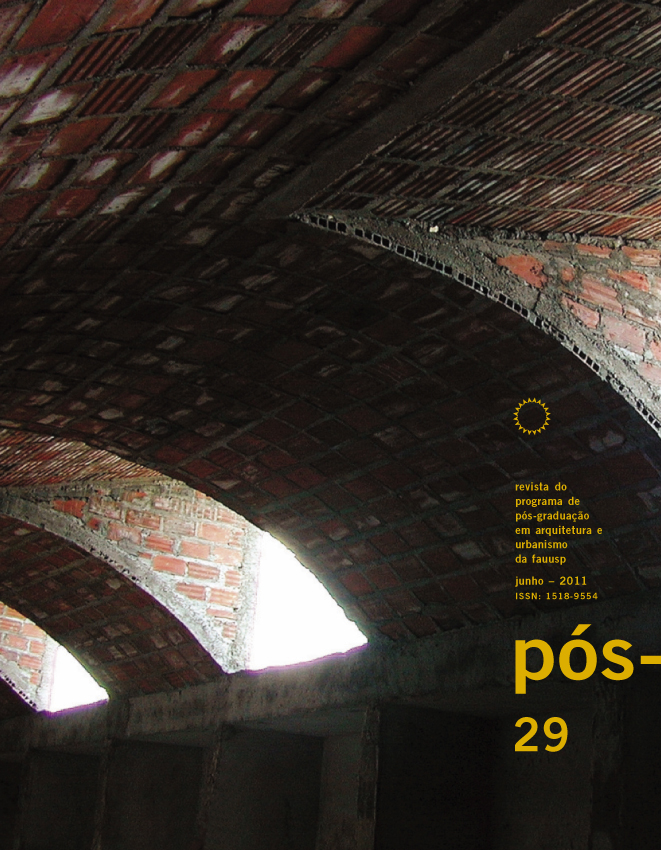About the void: the Cerdà corners, the paris boulevards, and the london squares
DOI:
https://doi.org/10.11606/issn.2317-2762.v18i29p80-94Keywords:
Urban voids, repetition, project, Barcelona, Paris, LondonAbstract
This article is part of an initial investigation of the urban void within the scope of architectural design. Therefore, the aim is to explore discussions about formal aspects of the voids that emerge from a projective intention and not those perceived as an automatic or inevitable consequence of the full. The empty space is considered a key element within the formal conception of architecture, not only by the descriptive potential that mass can have through its negative, but also because it is believed that in many situations these urban places appear with such projective force that may reveal the building space in a very coherent way - through repetition, density, perceptions of scales and proportions. These relations are perhaps inseparable, however usually not very evidenced. In three separate examples belonging to the three densest cities in Europe - Paris, Barcelona and London - these relations become visible and plausible to compare. Because even though they form part of different contexts, is relevant and common between them, the fact that in all three cases the void arises from a projective intention and is repeated systematically in the urban fabric, within relevant periods of intellectual and practical development of urban design. The main argument is that in the urban fabric designed by the engineer Ildefons Cerdà, in Barcelona, at each intersection of streets, formed by four chamfered corners in forty-five degrees, an empty space is created by the act of "cutting" the typical ninety degrees corner. Through a generic example of streets intersection in the Barcelona expansion project, it is verified how these urban voids configure the urban network and its relationship with two other cases: the Parisian boulevards and the London squares. Firstly the three examples are analyzed individually and in the second part a comparison of results previously obtained is made, in order to explore some conclusions.Downloads
References
BARTHES, Roland. El imperio de los signos. Madri: Mondadori, 1991.
BENJAMIN, Walter. Libro de los pasajes. Madri: Akal, 2005.
BERMAN, Marshall. Todo lo sólido se desvanece en el aire: la experiencia de la modernidad. Madri: Siglo Veintiuno, 1991.
BRU, Eduard. Comming from the south. Barcelona: Actar, 2001.
CERDÀ, Ildefons. Las cinco bases de la teoría general de la urbanización. Compilación, estructuración y comentario de Arturo Soria y Puig. Prólogo de Albert Serratosa. Madri: Electa España, 1996.
CULLEN, Gordon. El paisaje urbano: Tratado de estética urbanística. Barcelona: Blume, 1974.
GIEDION, Siegfried. Espacio, tiempo y arquitectura: El futuro de una nueva tradición. Madri: Dossat, 1978.
JACOBS, Allan B. The boulevard book: History, evolution, design of multiway boulevards. Cambridge: The MIT Press, 2002.
KRIER, León. Homenaje a Barcelona. Arquitecturas bis: información gráfica de actualidad, Barcelona, n. 20, p. 2-6, 1978.
MONCAN, P. de; HEURTEUX, C. Le Paris d’Haussmann. Paris: Les Éditions du Mécène, 2002.
MONTANER, Josep Maria. Repensar Barcelona. Barcelona: Edicions UPC, 2003.
MORRIS A. E. J. Historia de la forma urbana: Desde sus orígenes hasta la revolución industrial. Barcelona: Gustavo Gilli; 1984.
MUNTAÑOLA, J. La arquitectura como lugar. Barcelona: Ediciones UPC, 2001.
RASMUSSEN, Steen Eiler. London, the unique city. Cambridge: MIT Press, 1982.
SERGISON. J.; Bates, Stephen. Sameness. Barcelona: Gustavo Gilli, 2007. Papers 2: Sergison Bates Architects.
SOLÀ-MORALES, Manuel de. ¿Querido León, por que 22 x 22? Arquitecturas Bis: Información Gráfica de Actualidad, Barcelona, n. 20, p. 7-12, 1978.
SUMMERSON, JOHN. Georgian London. England: Penguin Books, 1978.
WENDERS, Wim. El acto de ver: Textos y conversaciones. Barcelona: Paidós Ibérica, 2005.
ZUCKER, Paul. Town and square: From the Agora to the village green. Nova York: Columbia University Press, 1959.
Downloads
Published
Issue
Section
License

This work is licensed under a Creative Commons Attribution 4.0 International License.
DIADORIM - Diretório de Políticas Editoriais












